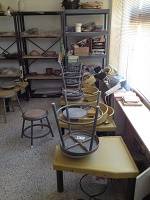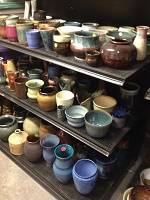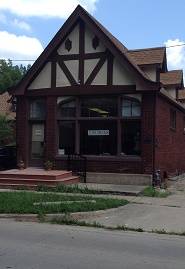Tucked away in an old corner store building, the CU Potters’ Club seems to be an unusual studio space. The brown and white building on the corner of Race and Washington Streets offers a place of worship on one side and the Club’s studio space on the other. The building has always caught my eye when I’ve taken the “scenic” route to downtown Urbana, and it seems that I’m not alone in wondering about what the Club has to offer.
I met with Club’s President Min-Hsuan Peng on a sunny Sunday afternoon to get a tour of the Club’s studio space. As Peng showed me around the building, he explained how the club works and how the different spaces were used. For $145 per session (or four months), members have 24-hour access to the building. Each member has a shelf space for works in progress either in the studio’s front room or basement. Members can use the electric potters’ wheels, prepared glazes, electric kiln, and other necessary tools to create their works of art. Also, each member is required to donate three pieces per session for the bi-annual sales.

After our walk and talk, I sent a few questions to Peng who shared them with members to help answer. Eagerly, a few members shared their responses with me.
———
Smile Politely: Has the club always been at 900 S. Race Street? I vaguely recall stories from my undergraduate years that building was an old grocery store.
Cathy Cunningham: The club has had several locations including the Urbana Park District’s Thornburn Recreation Center, which was torn down in the 1990s. Prior to moving to our current location on Race Street, the club was affiliated with the Champaign Park District. The Club was located in the basement of the Springer Recreation Center in downtown Champaign. The building at 900 S. Race Street was a Pizza World, an electronic repair shop, and a grocery store at various times over the years.
Beverly Rauchfuss: The portion of 900 S. Race that the studio is in had a used clothing store named Nearly New and a VCR/electronics repair shop that was operated by the husband of the husband and wife team who are the current owners of the building. I think that the building was originally a gas station, too.
SP: The Club seems to have a healthy membership group. Is everyone an amateur potter/ceramicist or are there professional potters in the club as well?
CC: Members have various levels of experience from taking a beginning class to having graduate level coursework in ceramics. Generally, professional potters are not members because production pottery (or mass production for market) is not allowed by the Club’s by-laws.
Min-Hsuan Peng: Occasionally, we have more experienced members who teach arts or run a ceramic studio at a school join our club. It is a wonderful opportunity both for them and the rest of our members. For the more experienced members, they can enjoy working on their own project in their own time. For the rest of the Club’s members, we get the opportunity to work with and learn from more experienced artists.
SP: Do club members work together often to improve their skills and learn new techniques?
CC: Club members interact informally while using the studio at the same time. Special workshops and programs are organized several times a year for members to improve or learn new techniques. Most recently, we asked professional potter Thomas Brewer of Griggs Street Pottery to offer several wheel throwing workshops at our club. We also arrange to have raku firings at Kickapoo Pottery, owned by Don Archer near Newman, IL. In the past, Ceramic Artist Dwain Naragon from Eastern Illinois University has conducted a stamping and impressions workshop at our studio. In addition club members have offered to share their expertise like throwing techniques or special interests like making fairy houses and making perfect pie dishes.
SP: Members seem to have specific obligations and are divided into committees (Clay, Cleanup and Maintenance, Glaze, and Firing). Can you explain what some of the obligations are for members and what these committees do?
BR: In order for the club to function, members need to perform maintenance responsibilities. For the Glaze committee, this entails making glazes when needed. They check the glazes periodically to make sure they are the correct consistency and help with making slips along with keeping the glaze area clean. Members are expected to put in approximately 8 hours of work per 4 month session.

(Quick aside from SP: Peng showed me the Glaze Committee’s workstation where they mixed different minerals and materials like zinc oxide and silica together to make the powder for the liquid glazes. Since pre-made liquid glaze is an available product, I was pleasantly surprised to learn that the Club makes their own, and members can learn to make some of the recipes as well. That hands-on experience is pretty great.)
MP: Clay committee recycles our clay and prepares the clay to the condition that’s workable again. Firing committee is solely responsible for loading and unloading pieces into and out of the kiln. Each committee requires a different amount of manpower, and we distribute our members according to the need of the committee. Needless to say, we have most of our members dedicated to the Cleaning and Maintenance committee.
SP: What do members like most about the club? Do they appreciate the space? The location? The variety of equipment available to them?
BR: We have great equipment that many could not afford by themselves. We have: a very new L&L (manufactured) kiln; a slab roller; an extruder; many Brent wheels; and a wide selection of glazes. The 24-hour access is wonderful. Some members come in late at night, and others come in to work in the early morning.
MP: In a studio with roughly 35 members all the time like ours, we have a variety of styles. I mean, there are a lot of ideas of how a bowl could look like, how a teapot could be made, and how a mug could function. We have creativity all over the places. That is a positive aspect to the club and, I think, what feeds every member to grow. There is nothing more joyful than to be surprised by an intriguing piece unloaded freshly from the kiln and a group of people gathering around and guessing what the glaze combinations that piece had.
SP: Classes are offered in the fall and the spring. Is there a date set for the fall class yet?
BR: The date will be decided upon in the fall, depending on the schedule of the teacher. Interested people should look at the website to see who to contact when the class is scheduled.
SP: What does it take to become a member?
MP: The requirements to become a member in our club are: to be able to perform committee duties and having the knowledge and ability to work alone in the studio without hurting yourself. The skill level of your clay work is irrelevant; after all, the whole idea of joining the club is to enjoy yourself and improve the skill.
———
Aside from the classes and bi-annual sales, the CU Potters’ Club also holds a special raku firing event once a year. Raku is a special technique where the glazed piece is exposed to extreme temperatures in a hot fire of mixed debris and then cooled very quickly. This firing technique creates a metallic sheen on the finished product. Typically, the CU Potters’ Club holds their outdoor raku event in early June, but luckily for all of us interested, they plan on holding the Raku event at Kickapoo Pottery in the fall.
While you may not be able to mosey on over to the studio and poke your head inside, you can keep an eye open and ear out for the next CU Potters’ Club sale or Raku event later this year. Or, if you’ve taken a class in ceramics at Parkland or have had an introduction to ceramics elsewhere, maybe try the Club for a session and let your creativity fly.
About the author…
Sarah Keim is a contributing writer for Smile Politely’s Arts section. She’s a bit of recluse on social media, but you might bump into her out in the wilds of C-U. Frequent sightings occur at farmers’ markets, movie theaters, and libraries.









 About the author…
About the author…